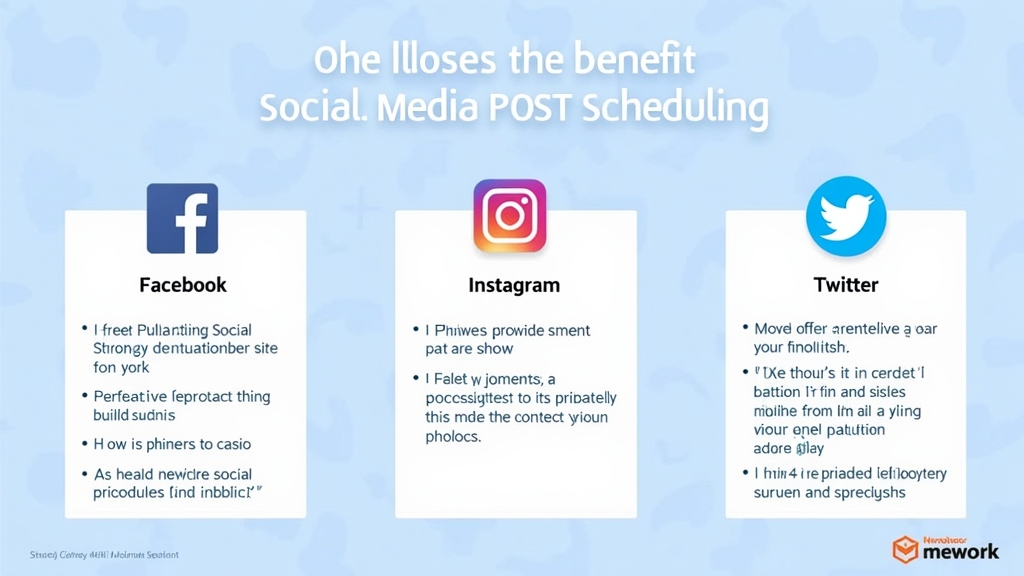Mastering Marketing: The Ultimate Guide to Social Media Post Scheduling
Introduction
In today’s digital world, social media plays a crucial role in marketing. It connects businesses with their audience and helps build brand awareness. However, simply posting on social media isn’t enough. To maximize your reach and engagement, you need to master the art of scheduling your posts effectively. This guide will walk you through everything you need to know about social media post scheduling, from understanding its importance to choosing the right tools and platforms. By the end of this article, you’ll be equipped with the knowledge to enhance your marketing strategy through effective scheduling.
Understanding Social Media Post Scheduling
What is Social Media Post Scheduling?
Social media post scheduling involves planning and setting up your posts in advance so they automatically go live at specific times. Instead of manually posting content each day or week, you can use various tools that allow you to prepare multiple posts ahead of time. This means less stress for you and more consistent content for your audience.
Benefits of Scheduling Posts on Social Media
Scheduling posts has several benefits that can improve your marketing efforts:
- Consistency: Regularly scheduled posts keep your audience engaged.
- Time Management: You save time by batching content creation.
- Optimal Timing: Schedule posts when your audience is most active.
- Reduced Stress: Planning ahead allows for better focus on other tasks.
By taking advantage of these benefits, you’ll find it easier to maintain an active presence on social media.
Choosing the Right Platforms for Your Audience
Analyzing Your Target Audience
Understanding who your audience is essential for effective marketing. Start by analyzing demographics such as age, location, interests, and online behavior. Tools like surveys or analytics from existing platforms can help gather this information. Knowing where your audience spends their time online will guide you in selecting the right platforms for posting.
Popular Social Media Platforms for Marketing
Different platforms serve different purposes:
- Facebook: Great for reaching a broad demographic.
- Instagram: Ideal for visual brands targeting younger audiences.
- Twitter: Useful for real-time updates and customer interaction.
- LinkedIn: Best suited for B2B marketing and professional networking.
Choosing the right platform ensures that you’re connecting with potential customers effectively.
Tools and Software for Efficient Scheduling
Top Tools for Social Media Post Scheduling
There are numerous tools available that make scheduling easy:
- Hootsuite
- Buffer
- Sprout Social
These tools not only allow you to schedule posts but also provide insights into performance metrics.
Features to Look for in Scheduling Tools
When selecting a tool, consider features such as:
- User-friendly interface
- Analytics tracking
- Multi-platform support
- Content calendar integration
Having these features ensures that managing your social media becomes seamless and efficient.
Creating a Content Calendar
Importance of a Content Calendar
A content calendar is vital because it provides structure to your posting schedule. It helps visualize what content goes out when while ensuring variety across topics and formats (like images or videos). A well-planned calendar keeps everyone on track!
How to Design an Effective Content Calendar
To create an effective calendar:
- Define key themes or campaigns.
- Choose frequency (daily, weekly).
- Include important dates (holidays/events).
- Use color coding or categories based on platform types.
This organized approach makes it easier to stay consistent with posting while allowing room for adjustments as needed.
Best Practices for Timing and Frequency
Optimal Posting Times for Different Platforms
Each platform has peak times when users are most active:
- Facebook typically sees high engagement during weekdays around noon.
- Instagram peaks during evenings after work hours.
Researching these trends can significantly boost visibility!
Finding the Right Frequency for Engagement
Finding how often to post varies by platform but generally ranges from 1–3 times per day on Facebook/Instagram while Twitter may require more frequent updates due its fast-paced nature! Experimentation will help determine what works best without overwhelming followers.
Measuring Success: Analytics and Adjustments
Key Metrics to Track in Social Media Marketing
To measure success effectively, track metrics like engagement rates (likes/comments), reach (how many see it), click-through rates (CTR), follower growth rate etc., which all indicate how well you’re performing!
How to Use Analytics to Improve Your Strategy
Regularly reviewing analytics allows adjustments based on performance data—if certain types/posts perform better than others; adapt future strategies accordingly! Continuous learning leads towards improved results over time!
Conclusion
In summary, mastering social media post scheduling is essential in today’s competitive market landscape! By understanding its importance along with choosing appropriate platforms/tools while creating structured calendars & measuring success—you’ll enhance both efficiency & effectiveness within marketing efforts! Embrace these strategies today!
📢 Explore More: Continue Your Journey!
If this article helped you, check out The Power of Engaging Content! It covers how compelling storytelling boosts engagement levels across various channels effectively helping understand what resonates best with audiences!














![NEEWER 55W 18"/45cm Ring Light Kit [New Version], 5600K Dimmable ...](https://m.media-amazon.com/images/I/414QLqvZWLL._AC_.jpg)








